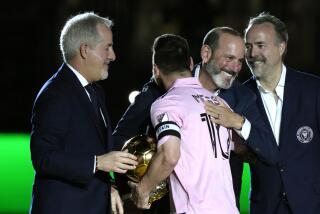Tennis has become a real melting pot
- Share via
NEW YORK -- If you are big on the idea that America must always be top dog on the block, the U.S. Open will bring about nothing but heartburn.
“We’re finished,” you’ll tell yourself, walking the sprawling grounds here, rarely spotting a player who calls one of the 50 states home. “When it comes to tennis, we’re a rare and dwindling breed, headed the way of the dodo bird and Britney Spears.”
There was a time when pro tennis players pretty much hailed from one of three global regions. They came from Australia and Western Europe. They also came from the United States, once a global tennis titan.
A look at the men’s and women’s singles draws confirms this. In 1978, those draws featured just under 100 Americans. On opening day in 2008, there were just under 40.
Filling the void is the rest of the world . . . almost every last corner of it.
The top two men’s singles players here are a Spaniard and a Swiss. The top male doubles team is a Canadian and a big server from Serbia.
The best pair of women’s singles players? Two Serbs. The biggest upset so far? Thursday’s loss by one of them, No. 1-ranked Ana Ivanovic. Her opponent hailed from France.
In the draws here are players from Slovakia and Estonia, India and South Africa, Japan and Chile . . . and that’s just to name a few.
It’s tough to be top dog of a block like this one. But maybe that’s OK. Maybe it’s good to receive a reality check, coming to terms with the idea that the U.S. probably will not stride atop the tennis world again. Embracing the fact that the tennis world is now a flat world full of people connected by hyperlinks, microchips, and, out in Queens this week, 120-mph serves backed by bolo-punch forehands.
“The best thing about this tournament is that it is just so amazingly diverse,” said George Easton, who told me he has been coming to the U.S. Open for four decades, time enough to watch the tournament grow from an elitist, American-dominated affair to the mish-mash blend it is today.
Easton figured now the U.S. Open could be seen as something of a laboratory, what with so many people from so many places playing and watching an event only a few miles from where the Twin Towers stood.
“It’s a real celebration of all different races and nationalities . . . it shows how people can come together.”
He spoke near Court 6, one of the string of courts that sit at the feet of Arthur Ashe Stadium. He’d just watched some of the slugfest between Italy’s Tathiana Garbin and Hungary’s Agnes Szavay. A few feet from him, on another court, China’s Yan Zi and Zheng Jie battled a pair from Poland.
Nearby were four more courts. There was a player from the Bahamas, one from India and one from Israel. There was a woman from Italy and two hard-hitting men from Sweden. Finally, an American, Lisa Raymond, a veteran doubles ace.
Perhaps I’m dealing in broad strokes, but watching the wide cast of players here it quickly became apparent that you could match playing style with native land.
The Eastern Europeans, some of whom grew up amid war, scrap and claw for every point. The Chinese are diligent and focused, determined to make their way. The Spanish have a bullfighter’s swagger. The French and Italians hit forehands with high style. The Swedes are stoics.
The Americans? You can spot them a mile away. Mostly, they’re straight-ahead bashers.
This international cast is hardly confined to the courts. The grounds at Flushing buzz with a heavy mix of language. Yesterday, during a 10-minute stretch in a small area near the shade beside Court 6, I heard conversations in Spanish, French, Italian, German and Polish.
There are reminders that we live on a globe still wrapped up in conflict. Roughly 30,000 fans have been coming daily to this event. Among them you’ll see a constant stream of New York cops. At the entrance, some of those cops give smiles and directions. Others have a more serious look and wear bulletproof vests, carry machine guns or hold mirrors used to peer under cars for bombs.
The tennis world, once precious and set apart, is now like the real world: pressed together, interesting, a bit tense, a place where Americans are more part of the crowd than top dogs on the block.
--
Kurt Streeter can be reached at kurt.streeter@latimes.com. To read previous columns by Streeter, go to latimes.com/streeter.
More to Read
Go beyond the scoreboard
Get the latest on L.A.'s teams in the daily Sports Report newsletter.
You may occasionally receive promotional content from the Los Angeles Times.











